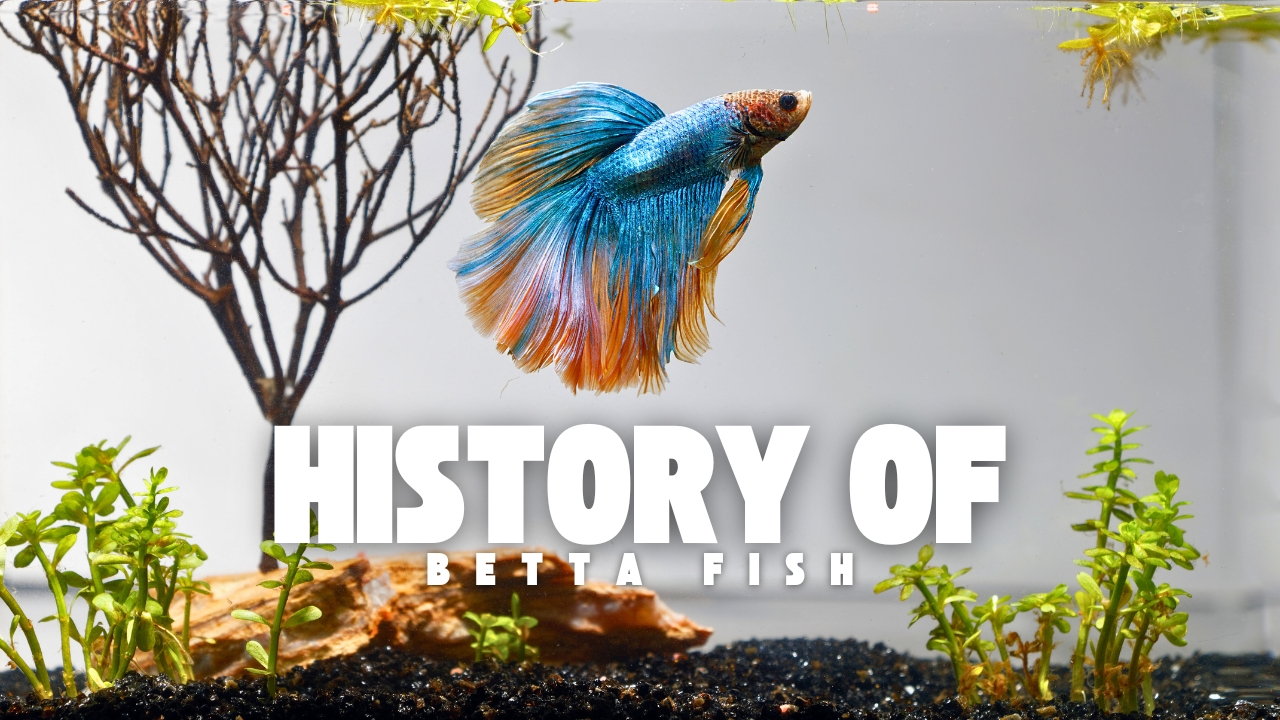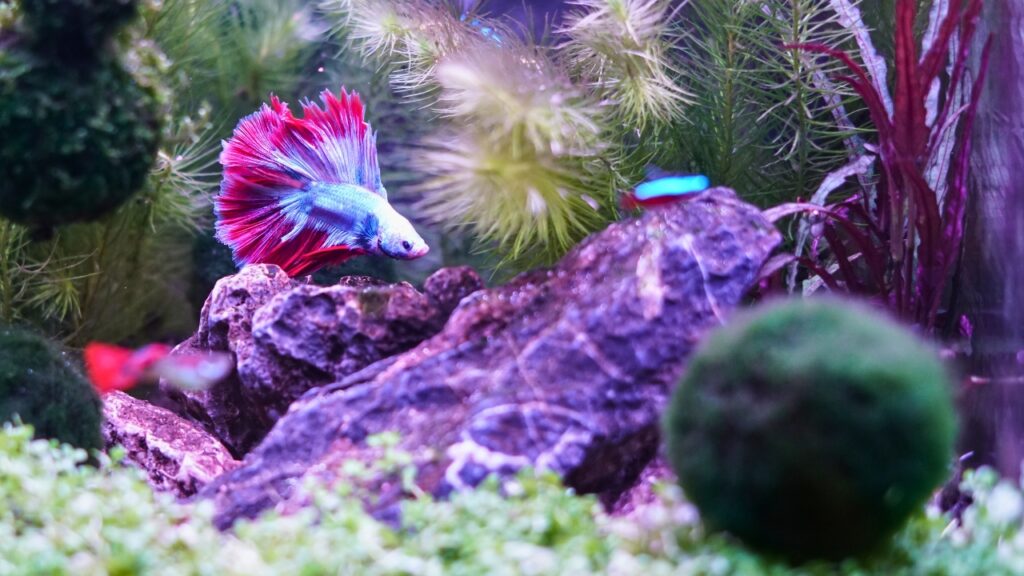History of Betta Fish: The Origins of Siamese Fighting Fish

Betta fish – famously known as Siamese fighting fish – have a rich and colorful history that stretches back centuries. These small, vibrant fish are among the oldest domesticated aquarium species, cherished in Southeast Asia long before they became popular pets around the world.
In this blog post, we’ll explore Betta fish origins, discovering where Betta fish come from, their cultural significance in Thailand, and how they spread across the globe. Written in friendly, simple language, this history is aimed at beginner fishkeepers, aquarium hobbyists, and students curious about the story behind these beautiful fish.
Table of Contents
Where Do Betta Fish Come From? (Origins in Southeast Asia)
Betta fish (scientific name Betta splendens) originally hail from the warm waters of Southeast Asia. In the wild, they live in shallow freshwater areas like rice paddies, irrigation ditches, marshes, and slow-moving streams across Thailand (formerly Siam) and neighboring countries such as namely Cambodia, Laos, Myanmar, Malaysia, Indonesia, Thailand, and Vietnam.

These habitats are often warm (around 80°F or 27°C) and low in oxygen, which led bettas to evolve a special breathing organ called the labyrinth organ. This adaptation allows them to breathe air from the water’s surface, an ability that helped them survive in tiny puddles and stagnant pools.
In their natural form, wild betta fish look quite different from the flowing-finned, brilliant-colored pets we see today. Wild bettas are typically a dull brownish or greenish color with much shorter fins. These earth-toned colors help them blend into muddy rice paddies and ponds. Early bettas had fins only as large as needed for basic swimming – nothing like the extravagant tails of modern show bettas.
Over the centuries, however, human intervention would transform this little drab fish into a kaleidoscope of colors. But before beauty, the Siamese fighting fish history began with their feisty nature.
Betta Fish in Thailand: Early History and Cultural Significance

Long before they adorned pet store shelves, betta fish were prized in their homeland for their fighting spirit. Betta fish in Thailand history goes back hundreds of years as part of local culture. In Thailand (Siam) and parts of Malaysia and China, children in rural villages would catch wild bettas from rice paddies and ponds as a pastime. They would put two males together and watch them spar, which is how the fish earned the name “Siamese Fighting Fish”.
These early matches were short-lived bouts – wild bettas would flare, nip, and quickly back off. But it didn’t take long for people to start gently breeding the feistiest fish to create more determined fighters. What began as children’s entertainment grew into a serious hobby and betting sport.
By the early 19th century, organized fish fights had become popular in Siam (Thailand), drawing spectators and high stakes gambling. People would wager not only money but sometimes even their personal belongings and livelihoods on these aquatic duels.
An 1840 account by Dr. Theodore Cantor – the first Western scientist to describe bettas – noted that Siamese people were “infatuated with the combats of these fishes” and would stake “considerable sums and sometimes their own persons and their families” on the outcome.
In other words, a man might bet his entire estate or even family members on a champion fighting fish! The fights could become intense, especially after selective breeding produced tougher fighters. Wild “plakat” bettas (from the Thai word pla kat, meaning “biting fish”) normally fought for only a few minutes, but once Siamese breeders started refining them for aggression, matches could stretch on for hours.
A winner wasn’t determined by killing the opponent – it was decided by one fish finally retreating, with the bravest, most relentless fighter crowned the victor. The popularity of betta fights in Siam grew so much that even the King took notice. By the mid-1800s, King Rama III of Siam saw an opportunity in this trending pastime. He began to regulate and tax betta fights, essentially licensing the activity to profit the kingdom.
The royal interest didn’t stop there – the Siamese fighting fish became a sort of living treasure. Prized specimens were collected by Siamese nobility and even presented as regal gifts. In fact, Thai royalty held bettas in high regard, and these fish were esteemed enough to be given to foreign visitors on special occasions.
In one famous instance in 1840, the King of Siam gifted some of his prized fighting fish to a Western acquaintance, which marked the beginning of the betta’s journey beyond Southeast Asia.
First Western Encounters and Scientific Naming of Betta Fish
When the King of Siam gave away those fighting fish in 1840, they eventually made their way to a Danish physician named Dr. Theodore Edward Cantor. Dr. Cantor, working for the British in Asia, became the first Western scientist to study and document the Siamese fighting fish. He bred and observed the fish, and in 1849 he wrote a scientific paper describing them. Cantor initially identified the fish as Macropodus pugnax, literally meaning “aggressive fish with large feet” (a name previously used for another species).
Along with a technical description, Cantor’s paper vividly described how the Siamese were passionate about fish fighting and how the fights were even a source of revenue for the Siamese king through licensing.
However, Cantor’s chosen name for the species turned out to be a case of mistaken identity – there was already a different fish named Macropodus pugnax. It wasn’t until several decades later, in 1909, that Charles Tate Regan, a British ichthyologist, formally reviewed the classification and gave the Siamese fighting fish a new scientific name. Regan christened it Betta splendens, which translates to “splendid betta” or is often poetically described as “beautiful warrior”.
This is the official scientific name that remains today. The word “Betta” itself has an interesting background. It’s pronounced “BET-tah,” not “BAY-tah” (despite the temptation to say it like the Greek letter beta). Many believe the name Betta was inspired by an ancient warrior clan known as the “Bettah”.
This would be fitting given the fish’s feisty nature. Another interpretation is that betta comes from a Malay word ikan betah, meaning “enduring fish,” due to their ability to survive tough conditions.
Either way, the term stuck. The species name splendens means “shining” or “splendid,” referring to the male fish’s brilliant flash of color when flaring. So, in essence, Betta splendens can be taken to mean “splendid enduring warrior” – a nod to both its resilience and fighting flair. In Thailand, these fish are still fondly called “Pla Kat”, which literally means “biting fish” in the Thai language.
This local name highlights their pugnacious character, the trait that first endeared them to observers. The English nickname “Siamese fighting fish” similarly honors their roots in Siam (Thailand) and their combative past.
From Siam to the World: Betta Fish Spread Across the Globe
Throughout the late 19th and early 20th centuries, betta fish transitioned from an Asian curiosity to a worldwide aquarium favorite. The first stop on this journey was Europe. By the 1890s, Siamese fighting fish had been introduced to European aquarists. In fact, records show that as early as 1874 a French aquarist named Pierre Carbonnier was successfully keeping and breeding bettas in Paris.
Carbonnier, famous for popularizing the paradise fish, obtained bettas (likely through colonial connections in Southeast Asia) and began raising them. Another French hobbyist, Mr. Jeunet, managed to breed a few bettas to maturity by 1892.
These European breeders were working with the wild-type fish – short-finned and green-brown – as the dazzling mutations had not yet arisen. From France, bettas made their way to other parts of Europe. The fish reached Moscow, Russia, and then Germany by the mid-1890s.
The European public was intrigued by these “fighting fish” from the exotic Far East, and they were often displayed in public aquariums or private collections as a novelty. At that time, their reputation as fierce little warriors probably overshadowed their looks. But this was about to change as new color varieties emerged.
Across the Atlantic, the United States got its first taste of bettas in the early 20th century. Frank Locke, an aquarist from San Francisco, is credited with bringing the first live betta fish to America around 1910.
These initial imports were the regular wild form, likely sent from Asia by trading partners or returning travelers. Bettas began to trickle into the U.S. aquarium trade, capturing interest for their hardiness and intriguing behavior. Then, in 1927, Frank Locke received a shipment of bettas that contained something extraordinary: a male with unusual, vibrant red fins.
At a time when most captive bettas still looked like their wild cousins, a brightly colored individual was a big deal. Mr. Locke was so impressed by this red-finned fish that he believed it might be a new species. He dubbed it “Betta Cambodia,” referencing the fish’s possible origin or the distinctive pale body/red fins coloration associated with that strain.
We now know this was not a different species at all, but rather one of the first major color mutations of Betta splendens. The so-called Cambodian strain (pale creamy body with red fins) became the foundation for creating more color varieties through selective breeding.
After the 1920s, Betta splendens truly began its transformation from a fighting fish to a popular ornamental pet. Breeders in the West and in Asia started focusing on enhancing the betta’s beauty rather than its brawling ability. By the mid-20th century, enthusiasts had developed an array of vibrant color morphs – reds, blues, greens, whites, and more – as well as longer, flowing fins. The classic “veil tail” betta (with a long, sweeping tail) was one of the first fancy types to become common in pet stores.
Over time, dedicated breeders introduced other spectacular tail forms: feathery crowntails, the semicircular halfmoons, double tails, delta tails, and giant bettas, to name a few. Each new variety made the betta fish even more popular in the aquarium hobby.
By the late 20th century, the Siamese fighting fish had completed its journey from the rice fields of Siam to aquariums worldwide. It became one of the best-selling tropical fish species, beloved for its hardy nature and dazzling appearance.
Ironically, the trait that started it all – aggression – is no longer the main attraction (in fact, today it’s something hobbyists have to manage by keeping males apart). Instead, it’s the betta’s beauty and personality that take center stage.
Modern Legacy of Betta Fish

Today, betta fish are celebrated not as fighters but as jewels of the aquarium. They are consistently ranked among the most popular pet fish due to their stunning colors, interactive personalities, and ability to thrive in small home tanks. Yet, their historical legacy is still visible. Male bettas will still flare their gills and spread their fins wide at the sight of a rival, showing off the same combative instinct that made their ancestors famous.
In some parts of Southeast Asia, underground betta fighting matches regrettably persist, but in many countries the practice of fish fighting has been outlawed as animal cruelty.
The modern emphasis is on appreciation of the betta’s beauty and charm rather than blood sport. In a nod to its cultural importance, the Siamese fighting fish was named the national aquatic animal of Thailand in 2019. This official recognition by the Thai government highlights how the betta is not just a common pet – it’s a symbol of national heritage and pride.
For a fish that once swam in muddy paddies and entertained village children, that’s quite an elevation in status. In Thailand today, you can even find betta exhibitions, competitions (for the best-looking fish, not fighting), and countless breeders devoted to preserving wild strains or creating new spectacular forms.
Despite all the changes through domestication, if you were to visit rural parts of Thailand or Cambodia, you might still spot wild-type bettas in their native waters. These little fighters remain very much part of the landscape, darting among rice stalks or under leaf litter in ponds. They might not be as eye-catching at first glance as a neon-blue halfmoon betta in a pet shop, but they are the living link to the original betta fish origins story.
Conclusion: From Fighting Fish to Beloved Pet
The history of the betta fish is a journey from paddy fields to parlors. What began as an aggressive swamp dweller became a cherished ornamental pet across the globe. Siamese fighting fish history is full of fascinating turns – from kids holding fish matches in Thai villages, to a king’s patronage and taxation, to Victorian scientists naming species, and finally to millions of households falling in love with these beautiful fish.
Betta fish have proven to be enduring little warriors in more ways than one. They endured through centuries of domestication, countless generations of selective breeding, and global travel, emerging as the “jewel of the orient” in the aquarium trade.
Next time you watch a betta fish flare its fins or build a bubble nest, remember that this small creature carries a big history. The Betta fish in Thailand were once the centerpiece of gambling events for royalty and commoners alike. Now, they grace our aquariums, bringing a touch of that tropical heritage into our homes.
The story of where betta fish come from – the origins of Siamese fighting fish – adds an extra layer of appreciation for this pet. It’s amazing to think that the gorgeously colored betta keeping you company on your desk or countertop has behind it hundreds of years of history and a legacy as one of the world’s oldest domesticated fish species.
From fierce fighting fish to friendly finned friend, the betta fish’s past and present truly showcase its unique journey through human culture and care.